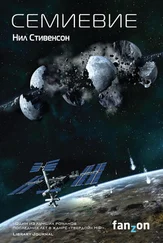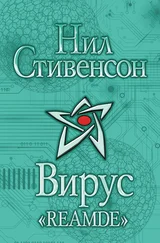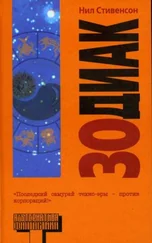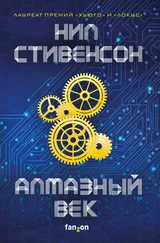They were ushered into a control room separated from the building’s cargo bay by a wall of windows that seemed inordinately thick. In spite of that, they were each given full-face respirators and taught how to put them on when and if a certain alarm were to sound. The previous conversation about sulfuric acid in the lungs had left little to the imagination and so all of them paid due attention. In the meantime, on the other side of the glass, workers in white bunny suits and respirators were working on a system that, to the eyes of a layperson, consisted entirely of plumbing. At the end closest to the open bay door, basically outside the building, was the object that seemed to be the point of it all, tended to by the bunny-suited priesthood on the far side of the glass. But even this was just plumbing. It was a pipe on a stand, aimed out at the world.
“Your Majesty,” T.R. said, “will know more than anyone else here—with the possible exception of the Right Honorable the Lord Mayor—about the V-1 buzz bomb.”
“The Farting Fury!” Bob said with surprising relish. “My granddad used to talk about them. He saw—and heard—one pass over him in Kent.”
Saskia knew the term at least as well as Bob. She was slower to respond, though, since she had been trained to think hard and choose her words carefully when any topic related to the Second World War came up in conversation. “One of Hitler’s advanced superweapons. The Nazis launched some of them from my country. They had some kind of a special engine. A primitive jet.”
“Pulse jet, it’s called,” T.R. said agreeably. “The pulsing style of operation is why Bob’s pawpaw referred to it as the Farting Fury. Absolutely terrible design for anything other than our exact purposes.”
Technicians here in the control room had been talking to the bunny suit wearers on the other side of the glass. These had been opening valves and checking gauges. On a signal, they all vacated the bay. Some kind of extremely well-organized procedure ensued, similar in its emotional arc to a rocket launch countdown. As such it dragged on for a few minutes. T.R. killed a little time by stepping up to the window and using a laser pointer to draw their attention to some details that might otherwise have been lost in the welter of pipes and cables. First was an ordinary white plastic five-gallon bucket, sitting on the floor, half full of sulfur. “Our high-tech S transportation modality. Totally human-powered,” T.R. explained, with the deadpan style that Saskia was coming to recognize as a hallmark of his personality. Near it was a rolling steel staircase, currently positioned so that it ran up to a platform at about head height. There was a vertical glass tube maybe a hand span in diameter and an arm’s length in height, mostly full of sulfur. Its top was open, presumably so that more sulfur could be dumped in from the bucket. Its bottom was swallowed in a stainless-steel fitting. “Fuel tank.” From there, things got hard to follow until T.R.’s laser dot tracked down the length of a pipe—or at least one could assume the existence of a pipe—jacketed in a tubular blanket of insulation and helpfully labeled S (MOLTEN) WARNING HOT. This led directly to the big pipe aimed out the door. “Fuel line,” T.R. explained. “Liquid sulfur’s flowing down it right now.” The laser dot terminated its journey on the device. “To the combustion chamber.”
A few sporadic thuds reached their ears, and their rib cages, through the glass, each accompanied by a burst of flame and a puff of smoke from the end of the pipe that was aimed out at Texas. After some false starts this settled into a steady rhythm. The tube looked like a fat machine gun emitting a series of muzzle flashes. Even through the glass, it was impressively loud. From miles away, such a sound could perhaps be likened to a long drawn-out fart.
The test ran for no more than fifteen seconds, then segued into a shutdown procedure that, if anything, was more elaborate than the startup. T.R., as close as he ever came to being sheepish, said, “We don’t like to run it very long, ’cause of the neighbors and the EPA.”
“Oh, I’m sure you can get away with murder in a place like this!” said Michiel.
“People do, in fact,” T.R. said.
“To connect the dots, if I may,” said Sylvester, “your engineers—drawn from the aerospace complex—have invented an engine—”
“The world’s shittiest by any metric you care to apply,” T.R. hastened to make clear.
“That uses sulfur—in molten form—as its fuel.”
“Yes.”
“And produces sulfur dioxide as its exhaust.”
“That follows.”
“Interesting! What’s next, then?”
“More dots. More connecting. First, a choo-choo ride.”
The property, though small by the standards of refinery complexes, was large enough that another short bus ride was in order. That put the huge sulfur cone and the farting fury behind them. They zigzagged around some other buildings and passed beneath cranes and conveyors used to load and unload trains. Then they emerged into an open logistics depot. Several parallel railroad tracks ran across it, connecting the waterfront to points inland. On the landward side those were funneled together into a single track. In other words, it was, among other things, a switching yard where trains could be assembled out of shorter strings of cars. The cars visible on the nearest tracks were, as one would expect, freight: mostly containers on flatbeds, some tarp-covered hoppers that presumably contained sulfur. The bus, moving gingerly over rough ground, cut behind these, bringing into view additional tracks. “Before you see what you are about to see and we part company for a couple of hours,” T.R. said, “I want it understood that I don’t, personally, give a shit about trains at all. I’m not gonna corner you and talk your ear off about trains. I’m not that guy. But I do know that guy. Long story. Old buddy. Too much money. Crazy about this stuff. Collects these things. Stores ’em on his property, fixes ’em up. Lended ’em to me. Likes to see ’em used. ‘Exercised’ he calls it. Good for the bearings or something. Voilà. Enjoy.”
On one of the parallel tracks, blocked from view to either side by strings of freight cars on adjoining lines, sat three consecutive railway carriages of a type that, to this point in her life, Saskia had only seen in museums of transportation.
In Amsterdam’s central train station, there was a special waiting room, technically for the use of Saskia or whoever was currently king or queen, but never actually used because it was so outrageously non-norMAL. It was where the kings of the Belle Époque would cool their heels waiting for their private trains. From there, when all was ready, they would be ushered into carriages that probably resembled the ones Saskia and the others were looking at now. They were the Victorian equivalent of today’s private bizjets. In the American version, they were not for hereditary royalty but for business magnates, thundering to and fro over the Gilded Age rail network with their families and support staff, smoking cigars and dashing off telegrams as Kansas or Appalachia glided by outside the windows.
As usual, there were helpers, trim and polite, wired up with earplugs. Each of the VIP guests was escorted to a different private suite on one of these cars, encouraged to wander, and reminded that the cars might, without warning, go into movement at any time. After freshening up, Saskia strolled up and down the length of this three-car string, gawking like an unabashed railway-buff tourist. Clearly each of these cars had a long and interesting backstory. But circumstantial evidence told her that one had been owned by a St. Louis beer baron of German ancestry. Another seemed to have been the property of a resource extraction magnate from the mountain West: mostly timber, some mining. The last was fancier, but harder to suss out. She guessed someone from New York, in finance. She mentally dubbed them the Beer Car, the Tree Car, and the Money Car. Saskia’s lodging was at the aft end of the Money Car and consisted of a bedchamber with en suite washroom complete with claw-footed cast-iron bathtub. A narrow passageway ran along one side of it. On the other side, big windows provided a view out of the left side of the train.
Читать дальше

![Нил Стивенсон - Криптономикон [litres]](/books/23868/nil-stivenson-kriptonomikon-litres-thumb.webp)







![Нил Стивенсон - Лавина [litres с оптимизированной обложкой]](/books/414066/nil-stivenson-lavina-litres-s-optimizirovannoj-ob-thumb.webp)
